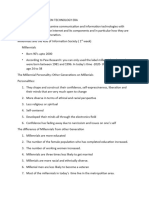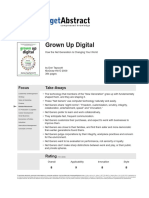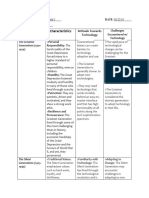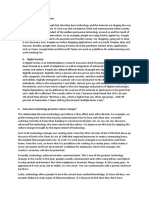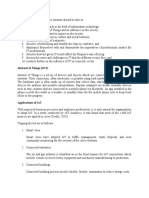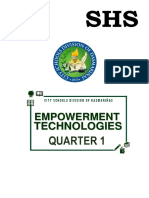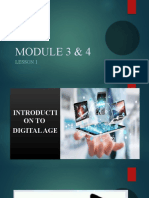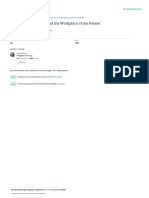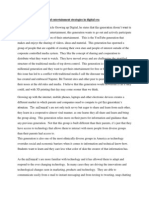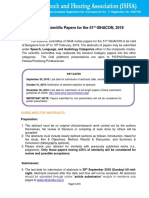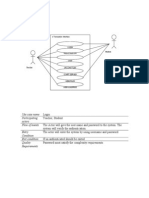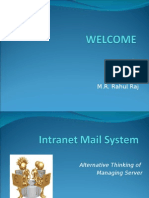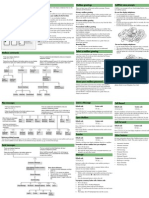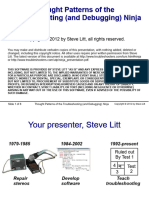1
2
�3
�4
�Research on how Digital natives have used technology revealed that within
five minutes of waking up, at least 25% of teenagers have reached for their
smartphones or other electronic devices (Ipsos MediaCT & Wikia, 2013).
Tweens (ages 8 to 12) average slightly more than four-and-a-half hours of
screen media time each day, while teens (ages 13 to 18) average slightly over
six-and-a-half hours on screens, and this excludes time spent in school or on
homework (Common Sense Media, 2015).
Furthermore, many teenagers multitask while using media, monitoring Twitter
feeds and SnapChat messages while watching videos on YouTube (Nass, 2013).
For many teenagers, technology use is a constant, with 44% reporting that
they never fully “unplug” (Ipsos MediaCT & Wikia, 2013).
References
Common Sense Media, 2015, The Common Sense census: Media use by teens and tweens. Available online at
https://www.commonsensemedia.org/sites/default/ files/uploads/research/census_researchreport.pdf. (Accessed on
24 February, 2017).
5
�Ipsos MediaCT & Wikia, 2013, 18 March. Generation Z: A look at the technology and media habits of today’s teens.
Available online at http://www.wikia.com/Generation_ Z:_A_Look_at_the_Technology_and_Media_Habits_of_
Today%E2%80%99s_Teens. (Accessed on 24 February 2017)
Internet World Stats, 2015, World internet users— statistics. Available online at http://www.internetworldstats.
com/stats.htm. (Accessed 24 February 2017).
Prensky, M, 2001, Digital natives, digital immigrants. On the Horizon, 9(5) pp 1–6.
5
�Characteristics of digital natives:
- Learn via participation (rather than passively- A serial sharer. For example,
Wikipedia which contents are developed by crowd and Britannica which is
developed by certain appointed people)
- See the world in a less hierarchical terms (the Internet levels the playing field,
making everyone more equal online)
- Heavy user of digital technologies
- Intuitive learners rather than linear learners (they do not refer to manuals)
- Multitasking brain capacity (their brains have developed a high capacity to
multitask and to rapidly task-switch (hopping))
6
�Research on Digital Immigrants by Nokia has showed that the average
American smartphone user checks their phone every six and a half minutes, or
up to 150 times per day (Spencer, 2013).
7
�8
�9
�10
�11
�12
�Answers:
1. “Digital natives” which is referred to young generation who rely heavily on
technology for learning, communicating, and entertainment. The digital natives is
young people within the range of 8 years old to 18 years old who used technology
heavily in their everyday activities .
“Digital immigrants” are people who was born before the widespread adoption of
digital technology. They can be considered as adults who have readily adopted
technology as it has become available are also increasingly comfortable with and
reliant on technology.
2. - Learn via participation (rather than passively- A serial sharer for example
Wikipedia which the content developed by crowd and Britannica who developed by
certain appointed people)
- See the world in less hierarchical terms
- Equipped with new skills
- Intuitive learners rather than linear learners
- Never knew a life without Internet
3. Choose any two answers.
Technological advances
Rapid development of technology infrastructure for example cloud computing,
13
�mobile computing, data analytics, and information security overcome economical,
technical and geographical limitations.
Digital Literacy
Digital experience was influenced by the widespread adoption of technologies. The
traditional channels of sales and services, along with other areas, have expanded
with digital channels for example social networks and social media. The rapid
advances and adoption of digital technology have increase people ability to use
digital technology, communication tools or networks to locate, evaluate, use
and create knowledge and information.
13
�14
�15
�16
�17
�Given the complex association between technology use and identity development,
business leaders and organizations need to consider how to address the possibility of
reduced self-awareness and authenticity among members of the digital workforce
while also remaining aware of the ways that technology might be used to promote
healthy identity development (Colberts et al , 2016)
Reference
Colbert, A., Yee, N. and George, G. (2016), The Digital Workforce and The Workplace
of The Future, Academy of Management Journal, Vol. 59, No. 3 pp 731-739.
18
�According to a Gallup poll (Newport, 2014), texting is the most prevalent form of
communication for adults under 50, with nearly two-thirds of 18 to 29 year olds
saying that they texted “a lot” on the previous day.
This is problematic because face-to-face communication has some advantages over
technologically mediated communication. In texts or emails, we lose the ability to ask
questions that do not have easy replies, to develop closeness, and to feel known and
understood. Even when we are with another person, we may miss out on the benefits
of face-to-face conversation because our smartphones are often close at hand, ready
to interrupt our conversations with a single buzz (Turkle, 2015).
References
Turkle, S, (2015), Reclaiming conversation: The power of talk in a digital age. New
York, NY: Penguin Press.
Newport, F, (2014), The new era of communication among Americans [Survey
report]. Available online at http://www.gallup.com/poll/179288/new-era-
communication-americans.aspx. (Accessed 31 January 2017)
19
�• Example of digital activities is playing online games and interacting in virtual
worlds which may develop important leadership skills while playing massively
multiplayer online role-playing games (MMORPGs) such as World of Warcraft or
EverQuest (Yee, 2014).
• Many of the tasks that must be completed in these games require the cooperation
of a group of players.
• These tasks also require a specific combination of roles, making it difficult to
quickly form an ad hoc group that possesses the necessary combination of skills.
Instead, players strategically form guilds made up of members with
complementary skill sets who have some degree of loyalty to one another ( Lisk,
Kaplancali, & Riggio, 2012).
References
Yee, N. (2014), The Proteus paradox: How online games and virtual worlds change
us—and how they don’t. New Haven, CT: Yale University Press.
Hsi, S. (2007), Conceptualizing learning from the everyday activities of digital kids.
20
�International Journal of Science Education, 29, pp 1509–1529.
Briggs, C., & Makice, K. (2012), Digital fluency: Building success in the digital age.
Bloomington, IN: SociaLens.
Lisk, T. C., Kaplancali, U. T., & Riggio, R. E. (2012), Leadership in multiplayer online
gaming environments. Simulation & Gaming, 43 pp 133–149.
20
�21
�IoT- In 2006, there were two billion smart connected devices, in 2015 there are 15 billion devices.
Although expectations vary, Intel predicts that by 2020 there will be 200 billion devices (Intel, 2015).
Reference
Intel (2015), A Guide to the Internet of Things. Intel Website (www.intel.com)
22
�IoT- In 2006, there were two billion smart connected devices, in 2015 there are 15 billion devices.
Although expectations vary, Intel predicts that by 2020 there will be 200 billion devices (Intel, 2015).
Reference
Intel (2015), A Guide to the Internet of Things. Intel Website (www.intel.com)
23
�Answers:
1. Individual identity development
- The ubiquitous presence of technology in people’s lives may limit opportunities to develop deep
levels of self-awareness and to behave authentically. Opportunity to create an aspirational image
rather than presenting authentic self such as through social media profile and photos may hide
people’s awareness of who they really are and their ability to act authentically.
Interpersonal relating
- Most digital natives and digital immigrants rely heavily on communicating via email or text, thus
they have trouble starting and ending conversations, and reports state that talking on the
telephone makes them nervous.
2. - Computer programming
- Data analytics and database architecture
3. Digital technologies are enabling workplace innovations such as remote working, co-working spaces,
and teleconferencing.
Organizations are likely to have an ever-smaller pool of core full-time employees for fixed functions,
backed up by colleagues in other countries (offshoring), external consultants and contractors for
specific projects (outsourcing) and external talent pool of individual experts from the crowd
(crowdsourcing).
24
�25
�26
�The independent sector of freelancing is growing, broadening, and getting younger
[135] worldwide.
Nearly one in three working Americans is an independent worker (Berland, 2014);
(Matthews, 2015).
Freelancer.com is the biggest platform for freelancing labour market, and now
connects over 17 million employers across 247 countries (Freelancer.com, 2015) with
over eight million projects posted. The number of users have grown from one million
in September 2009 to 10 million users in January 2014
One survey found 88 per cent would continue with freelancing even if they were
offered a traditional full-time position (Emergent Research, 2014).
References
Berland, E., (2014), Freelancing in America: A national survey of the new workforce, Freel. Union Elance-oDesk.
Matthews, B., (2015), Freelance Statistics 2015: The Freelance Economy in Numbers. Available online at
benrmatthews.com. (Accessed 1 February 2017)
27
�Freelancer.com, (2015), Freelancer.com About, no. 26.10.2015. Available online at Freelancer.com (Accessed 1
February 2017)
Emergent Research, (2014), Online Survey of 1186 Freelancers - May 14-28, 2014. Emergent Research.
MBO Partners, (2015), MBO Partners State of Independence in America 2015. Five Years of Insight on the Growth
of the Independent Workforce. Available online at www.mbopartners.com. (Accessed 1 February 2017)
27
�28
�29
�30
�IoT- In 2006, there were two billion smart connected devices, in 2015 there are 15
billion devices. Although expectations vary, Intel predicts that by 2020 there will be
200 billion devices (Intel, 2015).
Intel (2015), A Guide to the Internet of Things. Intel Website (www.intel.com)
31
�Suggested answers:
1. In peer-to-peer economy, by using digital technology, an individual can deal with another
individual to buy or sell goods and services directly with each other, without intermediation by a
third-party, or without the use of a company of business thus, encouraging the expansion of the
freelancer concept.
2. The answer is referring to the graph in Slide 30 and discuss about the job with the students.
32
